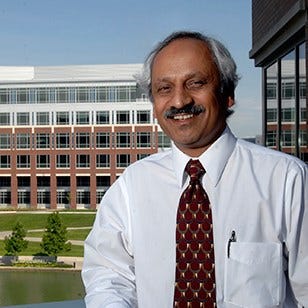Report Puts CTSI Under Magnifying Glass
 Indiana life sciences leaders say CTSI’s progress is largely a result of CTSI Director Dr. Anantha Shekhar.
Indiana life sciences leaders say CTSI’s progress is largely a result of CTSI Director Dr. Anantha Shekhar.
Subscriber Benefit
As a subscriber you can listen to articles at work, in the car, or while you work out. Subscribe NowWhile many Hoosier life sciences leaders anecdotally sing the praises of the Indiana Clinical and Translational Science Institute (CTSI), the state’s life sciences initiative BioCrossroads has issued a report that serves as a data-driven “measuring stick” of sorts for the young institute. Grinding through publicly-reported data, interviews with leaders at peer institutes and literature reviews, Indianapolis-based Faegre BD Consulting reveals how Indiana is performing within the national program.
“Indiana stacks up quite favorably in many respects and, in some regards, punches above its weight in terms of its ability to deliver translational and clinical research,” says Debra Lappin, Principal at Faegre Baker Daniels and leader of its Health and Biosciences Consulting Team. “It holds its own with peer institutions that have double or more National Institutes of Health (NIH) funding overall.”
CTSI launched in 2008, uniting some of Indiana’s heaviest hitters to speed translational research, which is the process of moving laboratory discoveries to human clinical studies. Indiana’s site is one of 62 academic medical institutions throughout the U.S. that are part of the NIH’s Clinical and Translational Science Award (CTSA) program, which began in 2006. CTSI is led by the Indiana University School of Medicine, in partnership with Purdue University and the University of Notre Dame.
BioCrossroads commissioned the study, called “The Clinical and Translational Science Award Program – A Report on Indiana’s Position,” which compares CTSI with five other award sites.
“[When CTSI launched in 2008], the NIH was saying your research needs to ‘be about’ something or needs to be working with broader partners to whom things can be translated,” says BioCrossroads President and Chief Executive Officer David Johnson. “And an awful lot of applicants didn’t understand what that meant or were not able to produce, and in [CTSI’s] case, those were serious collaborations that have led to some remarkable things that have happened with the CTSI.”
Johnson says the report underscores CTSI’s ability to forge relationships with the private sector. He notes a key accomplishment is the Strategic Pharma-Academic Research Consortium for Translational Medicine (SPARC). Coordinated by IU, SPARC is a new network of 17 Midwest CTSA hubs, a collaboration Johnson says other sites “are only thinking about.” Additionally, CTSI has partnered with Covance to establish a Phase 1 unit in Indianapolis to spur early-stage clinical research activity.
Indiana life sciences leaders say CTSI’s progress is largely a result of its leadership, namely CTSI Director Dr. Anantha Shekhar.
“[CTSI] stands out because of its people,” says Lappin. “CTSI is led by a very highly-regarded principal investigator, and that’s Dr. Shekhar. Universally, his leadership is praised.”
The report, authored by Faegre BD Partner David Zook, is also in response to the NIH’s request for the institutions to self-evaluate, looking at whether millions in funding are making a difference in human health. That’s a particular challenge for CTSI; of the five CTSAs examined in the report, Indianapolis has the lowest “Health Ranking” for its population.
“What impressed us is the CTSI program is taking on the challenge to be sure this isn’t research just for research’s sake, but that it’s going to tie into changes in the health of the region,” says Lappin. “That’s a big nut to crack, but we see Shekhar and his team intend to look at these metrics over the next decade, and that’s an impressive commitment they’re making.”
And Lappin believes perhaps that will be the CTSI’s most effective measuring stick moving forward: looking closely at population health in the Indianapolis region to evaluate if the institute is “moving the needle” and making a difference in Hoosiers’ health.
Johnson says CTSI has a “leased executive” program that allows a person from the private sector to split their duties with CTSI.
Lappin says CTSI is “forward-leaning” in how it can collaborate with health systems.

